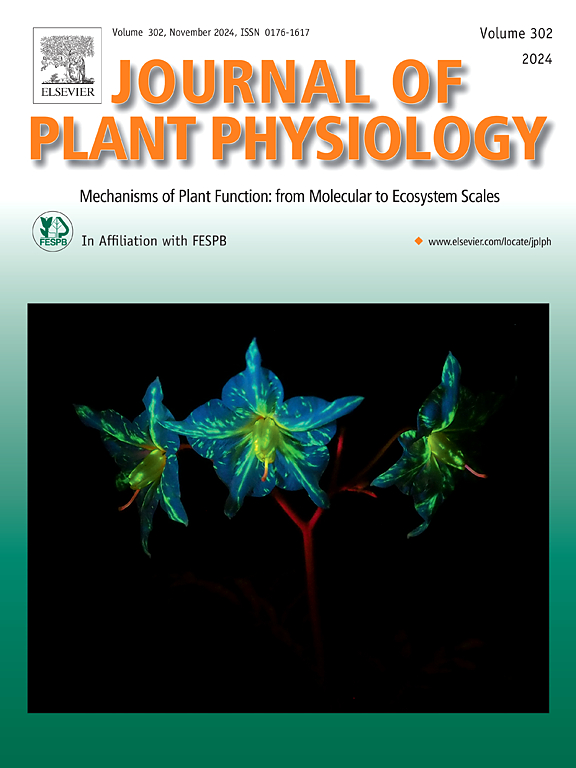PdSABP2A involved in jasmonic acid biosynthesis regulates Anoplophora glabripennis resistance of Populus deltoides ‘Shalinyang’
IF 4.1
3区 生物学
Q1 PLANT SCIENCES
引用次数: 0
Abstract
Populus deltoids ‘Shalinyang’ (PdS) is a new poplar variety with insect resistance cultivated in the western region of China. Anoplophora glabripennis (ALB) is an important forestry pest that causes great harm to poplar trees. However, the research on the insect resistance mechanism of PdS is still unclear, so exploring its defense response mechanism against ALB can provide theoretical and technical support for the subsequent cultivation of new varieties of poplar suitable for extensive planting and resistant to biotic stress. This study primarily aims to elucidate the molecular mechanisms underlying PdS's inducible resistance by jasmonic acid (JA). Here, 50 μM JA was applied to 1-year-old PdS plants to verify its anti-insect effect in PdS. It was found that superoxide dismutase (SOD) activity and hydrogen peroxide (H2O2) content increased, malondialdehyde (MDA) content decreased, and the feeding area of ALB leaves and the number of stem bite marks decreased by 56.92 % and 49.33 % respectively compared to the control group. The results indicated that JA treatment had a positive regulatory effect on insect resistance in PdS. Based on the transcriptome data, the key gene PdSABP2A was screened from the methylesterase (MES) gene family that played an important role in plant defense response. The expression level of PdSABP2A gene also significantly increased in the external JA treatment experiment. The virus-induced gene silencing (VIGS) experiment was used for gene function validation, and it was found that the expression level of PdSABP2A gene decreased by 73.72 %, and the JA content also significantly decreased. In addition, PdS subjected to the VIGS silencing treatment were more severely nibbled by ALB. The larvae inside PdS plants grew faster, had higher activity of digestive and defense enzymes, and lower mortality rates, all of which indicated a decrease in PdS insect resistance. These findings indicated that the PdSABP2A gene is involved in regulating the synthesis of JA and inducing the defense response of PdS against ALB.
参与茉莉酸生物合成的PdSABP2A调控沙林阳杨光肩天牛抗性
沙林杨是中国西部地区培育的一个抗虫杨树新品种。光肩天牛(Anoplophora glabripennis, ALB)是一种严重危害杨树的重要林业害虫。然而,对PdS的抗虫机制的研究尚不清楚,因此,探索其对ALB的防御反应机制,可以为后续培育适合广泛种植、抗生物胁迫的杨树新品种提供理论和技术支持。本研究的主要目的是阐明茉莉酸(jasmonic acid, JA)诱导抗性的分子机制。本研究将50 μM JA应用于1年生的PdS植株,验证其对PdS的抗虫作用。结果表明,与对照组相比,超氧化物歧化酶(SOD)活性和过氧化氢(H2O2)含量升高,丙二醛(MDA)含量降低,白草叶的取食面积和茎咬痕数分别减少了56.92%和49.33%。结果表明,茉莉酸处理对PdS的抗虫性有正向调节作用。基于转录组数据,从甲基酯酶(MES)基因家族中筛选出在植物防御反应中发挥重要作用的关键基因PdSABP2A。体外JA处理实验中PdSABP2A基因的表达水平也显著升高。采用病毒诱导基因沉默(VIGS)实验进行基因功能验证,发现PdSABP2A基因表达量下降73.72%,JA含量也显著降低。此外,经过VIGS沉默处理的PdS更严重地被ALB蚕食。幼虫生长速度快,消化酶和防御酶活性高,死亡率低,表明PdS的抗性降低。这些发现表明PdSABP2A基因参与调控JA的合成并诱导PdS对ALB的防御反应。
本文章由计算机程序翻译,如有差异,请以英文原文为准。
求助全文
约1分钟内获得全文
求助全文
来源期刊

Journal of plant physiology
生物-植物科学
CiteScore
7.20
自引率
4.70%
发文量
196
审稿时长
32 days
期刊介绍:
The Journal of Plant Physiology is a broad-spectrum journal that welcomes high-quality submissions in all major areas of plant physiology, including plant biochemistry, functional biotechnology, computational and synthetic plant biology, growth and development, photosynthesis and respiration, transport and translocation, plant-microbe interactions, biotic and abiotic stress. Studies are welcome at all levels of integration ranging from molecules and cells to organisms and their environments and are expected to use state-of-the-art methodologies. Pure gene expression studies are not within the focus of our journal. To be considered for publication, papers must significantly contribute to the mechanistic understanding of physiological processes, and not be merely descriptive, or confirmatory of previous results. We encourage the submission of papers that explore the physiology of non-model as well as accepted model species and those that bridge basic and applied research. For instance, studies on agricultural plants that show new physiological mechanisms to improve agricultural efficiency are welcome. Studies performed under uncontrolled situations (e.g. field conditions) not providing mechanistic insight will not be considered for publication.
The Journal of Plant Physiology publishes several types of articles: Original Research Articles, Reviews, Perspectives Articles, and Short Communications. Reviews and Perspectives will be solicited by the Editors; unsolicited reviews are also welcome but only from authors with a strong track record in the field of the review. Original research papers comprise the majority of published contributions.
 求助内容:
求助内容: 应助结果提醒方式:
应助结果提醒方式:


